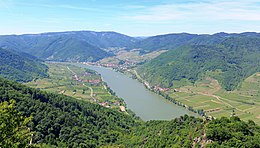
Back Wachau Afrikaans Wachau BAR Вахау Byelorussian Вахаў BE-X-OLD Вахау Bulgarian Wachau BS Wachau Catalan Wachau Czech Wachau Danish Wachau German
| UNESCO World Heritage Site | |
|---|---|
 | |
| Location | Lower Austria, Austria |
| Criteria | Cultural: (ii)(iv) |
| Reference | 970 |
| Inscription | 2000 (24th Session) |
| Area | 18,387 ha (45,440 acres) |
| Buffer zone | 2,942 ha (7,270 acres) |
| Website | www |
| Coordinates | 48°21′52″N 15°26′3″E / 48.36444°N 15.43417°E |


The Wachau (German pronunciation: [vaˈxaʊ̯] ) is an Austrian valley with a picturesque landscape formed by the Danube river. It is one of the most prominent tourist destinations of Lower Austria, located midway between the towns of Melk and Krems that also attracts "connoisseurs and epicureans" for its high-quality wines.[1] It is 36 kilometres (22 mi) in length[2] and was already settled in prehistoric times. A well-known place and tourist attraction is Dürnstein, where King Richard I of England was held captive by Leopold V, Duke of Austria. The architectural elegance of its ancient monasteries (Melk Abbey and Göttweig Abbey), castles and ruins combined with the urban architecture of its towns and villages, and the cultivation of vines as an important agricultural produce are the dominant features of the valley.[3][4][5]
The Wachau was inscribed as "Wachau Cultural Landscape" in the UNESCO List of World Heritage Sites in recognition of its architectural and agricultural history, in December 2000.[3][6]
- ^ "Wachau Wine Region". Wine-Searcher.
- ^ "Getting there - Wachau Nibelungengau Kremstal". www.donau.com.
- ^ a b "Wachau Cultural Landscape". Unesco.org. Retrieved December 5, 2010.
- ^ "Wachau (Austria) No 970" (PDF). Unesco.org. pp. 22–26. Retrieved December 5, 2010.
- ^ "Welcome to the region Wachau-Nibelungengau-Kremstal!". Wachau Official Website. Retrieved May 27, 2015.
- ^ "United Nations Educational, Scientific And Cultural Organization Convention Concerning The Protection Of The World Cultural And Natural Heritage, World Heritage Committee:Twenty-fourth session, Cairns, Australia:27 November – 2 December 2000: Report". Unesco.org. Retrieved December 5, 2010.
© MMXXIII Rich X Search. We shall prevail. All rights reserved. Rich X Search

